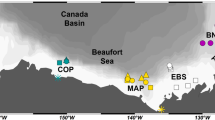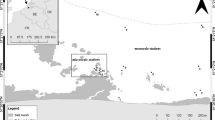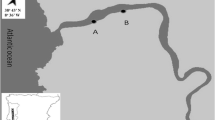Abstract
Habitat heterogeneity is one of the major factors shaping community structure and diversity of many fauna. The present study aimed to reveal the influence of habitat heterogeneity on the nematode community structures and diversity in a seasonally hypoxic bay (Omura Bay of Nagasaki in Western Kyushu, Japan). The severity of hypoxia varies typically along north–south axis of the bay, which is intensified southwardly. Nematode abundance and diversity were highest in the northern site than the other sites, and nematode communities were clustered into three groups by sampling site. There were significant differences in composition (Two-way ANOSIM, Rho = 0.726, p < 0.05) and in feeding types (Two-way ANOSIM, Rho = 0.589, p < 0.05) among the groups. Organic matter content alone was the best predictor for the shift in nematode compositions (BIOENV procedure, Correlation = 0.666, p < 0.05), whereas the combination of salinity and DO correlated well with the shift in nematode feeding types (Correlation = 0.568, p < 0.05). These findings strongly suggest that the diversity and the structures of nematode assemblages were strongly affected by the habitat heterogeneity in terms of seasonal DO availability, salinity change and persistent food availability (organic carbon accumulation) over the surface sediment of the bay.








Similar content being viewed by others
References
Adão H, Alves AS, Patrício J, Neto JM, Costa MJ, Marques JC (2009) Spatial distribution of subtidal Nematoda communities along the salinity gradient in southern European estuaries. Acta Oecologica 35(2):287–300
Boon AR, Duineveld GCA (1998) Chlorophyll a as a marker for bioturbation and carbon flux in southern and central North Sea sediments. Mar Ecol Prog Ser 162:33–43
Breitburg D, Levin LA et al. (2018) Declining oxygen in the global ocean and coastal waters. Science 359(6371)
Broman E, Raymond C, Sommer C, Gunnarsson JS, Creer S, Nascimento FJA (2018) Salinity drives meiofaunal community structure dynamics across the Baltic ecosystem. Mol Ecol 28(16):3813–3829
Clarke KR, Warwick RM (2001) Change in marine communities: an approach to statistical analysis and interpretation, 2nd edn. Primer-E, Plymouth
Diaz RJ, Rosenberg R (2008) Spreading dead zones and consequences for marine ecosystems. Science 321(5891):926–929
Fukumoto T, Kobayashi N (2005) Bottom stratification and water exchange in enclosed bay with narrow entrance. J Coast Res 21:135–145
Giere O (2009) Meiobenthology: the microscopic motile fauna of aquatic sediments. Springer, Berlin
Gooday AJ, Bett BJ et al (2010) Habitat heterogeneity and its influence on benthic biodiversity in oxygen minimum zones. Mar Ecol 31(1):125–147
Higgins RP, Thiel H (1988) Introduction to the study of meiofauna. Smithsonian Institution Press, Washington DC, pp 80–81
Iizuka S, Min SH (1989) Formation of anoxic bottom waters in Omura Bay. J Oceanogr Soc Jpn 26:75–86 (in Japanese)
Jessen GL, Lichtschlag A et al (2017) Hypoxia causes preservation of labile organic matter and changes seafloor microbial community composition (Black Sea). Sci Adv 3(e1601897):1–14
Kovalenko KE, Thomaz SM, Warfe DM (2012) Habitat complexity: approaches and future directions. Hydrobiologia 685(1):1–17
Kruskal WH, Wallis WA (1952) Use of ranks in one-criterion variance analysis. J Am Stat Assoc 47(260):583–621
Lambshead PJD (1986) Sub-catastrophic sewage and industrial waste contamination as revealed by marine nematode faunal analysis. Mar Ecol Prog Ser 29(29):247–260
Levin LA (2003) Oxygen minimum zone benthos: adaptation and community response to hypoxia. Oceanogr Mar Biol Annu Rev 41:1–45
Levin LA, Huggett CL, Wishner KF (1991) Control of deep-sea benthic community structure by oxygen and organic-matter gradients in the eastern Pacific Ocean. J Mar Res 49(4):763–800
Levin LA, Sibuet M, Gooday AJ, Smith CR, Vanreusel A (2010) The roles of habitat heterogeneity in generating and maintaining biodiversity on continental margins: an introduction. Mar Ecol 31(1):1–5
Mori F, Umezawa Y, Kondo R, Wada M (2018) Effects of bottom-water hypoxia on sediment bacterial community composition in a seasonally hypoxic enclosed bay (Omura Bay, West Kyushu, Japan). FEMS Microbiol Ecol 94(5):1–14
Neira C, King I, Mendoza G, Sellanes J, De Ley P, and Levin LA (2013) Nematode community structure along a central Chile margin transect influenced by the oxygen minimum zone
Nguyen QTD, Ueda R, Mori F, Kang T, Kim D, Shimanaga M, Wada M (2018) Response of nematode community structure to hypoxia in an enclosed coastal sea, Omura Bay, for three consecutive years. Plankton Benthos Res 13(2):59–65
Platt HM (1977) Vertical and horizontal distribution of free-living marine nematodes from Strangford Lough, Northern Ireland. Cahiers de Biologie Mar 18(1959):261–273
Schmidt-Rhaesa A (2013) Gastrotricha, Cycloneuralia and Gnathifera, Nematoda, vol 2. De Gruyter, Berlin, pp 128–140
Setoguchi Y, Nomaki H, Kitahashi T, Watanabe H, Inoue K, Ogawa NO, Shimanaga M (2014) Nematode community composition in hydrothermal vent and adjacent non-vent fields around Myojin Knoll, a seamount on the Izu-Ogasawara Arc in the western North Pacific Ocean. Mar Biol 161(8):1775–1785
Spurrier JD (2006) Additional tables for Steel-Dwass-Critchlow-Fligner distribution-free multiple comparisons of three treatments. Commun Stat Simul Comput 35(2):441–446
Stein A, Gerstner K, Kreft H (2014) Environmental heterogeneity as a universal driver of species richness across taxa, biomes and spatial scales. Ecol Lett 17(7):866–880
Takahashi T, Nakata H, Hirano K, Matsuoka K, Iwataki M, Yamaguchi H, Kasuya T (2009) Upwelling of oxygen-depleted water (Sumishio) in Omura Bay, Japan. J Oceanogr 65:113–120
Takatsuji T, Nakashima T, Furui K, and Sera K (2017) Relations among Stable and Radioactive Elements Contained in Aerosol and Trajectories of the Nagasaki Atmosphere from 2013 to 2017. NMCC Annual Report 24
Traunspurger W, Majdi N (2017) Meiofauna. Methods in Stream. Ecology 1:273–295
Vereș DS (2002) A comparative study between loss on ignition and total carbon analysis on mineralogenic sediments. Studia UBB Geologia 47(1):171–182
Wada M, Suzuki S, Nara T, Umezawa Y, Shimanaga M, Matsuoka K, Nakata H (2012) Microbial community respiration and structure of dead zone sediments of Omura Bay, Japan. J Oceanogr 68(6):857–867
Warwick RM (1971) Nematode associations in the exe estuary. J Mar Biol Assoc UK 51(2):439–454
Warwick RM, Platt HM, and Somerfield PJ (1998a) Free-living Marine Nematodes (Part 2: British Chromadorids) - FSC Field Studies Council, Shrewsbury
Warwick RM, Platt HM, and Somerfield PJ (1998b) Free-living Ma- rine Nematodes (Part 3: Monhysterids) - FSC Field Studies Council, Shrewsbury
Yokoyama H (1995) Macrobenthic assemblages in Omura Bay I: community parameters versus bottom environmental factors (in Japanese). Bull Natl Res Inst Aquacult 24:43–53 (in Japanese with English abstract)
Acknowledgements
This study was partially supported by JSPS KAKENHI (Grant numbers, JP17H03854 and JP18K19236), MEXT, Japan. We thank the help provided by Dr. S. Takeuchi and Dr. F. Mori with the grain size analyses. We would like to thank Dr. S. Takeda for valuable advice on Chlorophyll a concentration measurement. Finally, the authors appreciate the editor and anonymous reviewers whose valuable comments improved the manuscript.
Author information
Authors and Affiliations
Corresponding author
Electronic supplementary material
Below is the link to the electronic supplementary material.
10872_2020_558_MOESM1_ESM.pptx
Supplementary material 1 (PPTX 84 kb) Fig. S1 Shannon and Simpson indexes of nematode diversity at the four sampling sites of Omura Bay between June and October in 2017. Hypoxic months were underlined to separate from normoxic ones
Rights and permissions
About this article
Cite this article
Nguyen, Q.T.D., Kim, D., Shimanaga, M. et al. Horizontal distribution of nematode communities in a seasonally-hypoxic enclosed sea (Omura Bay, Japan). J Oceanogr 76, 479–489 (2020). https://doi.org/10.1007/s10872-020-00558-2
Received:
Revised:
Accepted:
Published:
Issue Date:
DOI: https://doi.org/10.1007/s10872-020-00558-2




